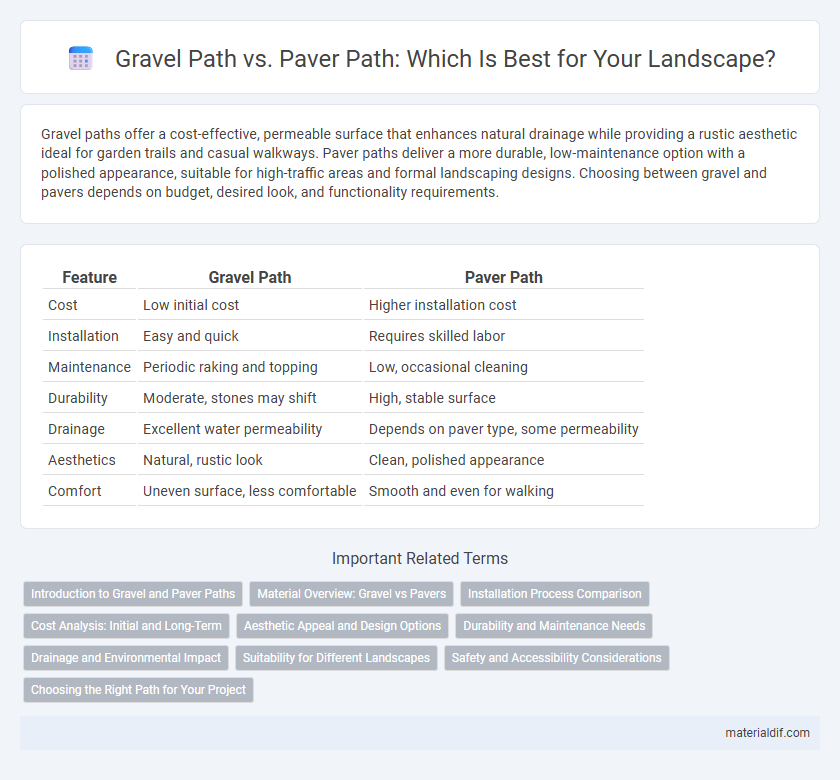Gravel paths offer a cost-effective, permeable surface that enhances natural drainage while providing a rustic aesthetic ideal for garden trails and casual walkways. Paver paths deliver a more durable, low-maintenance option with a polished appearance, suitable for high-traffic areas and formal landscaping designs. Choosing between gravel and pavers depends on budget, desired look, and functionality requirements.
Table of Comparison
| Feature | Gravel Path | Paver Path |
|---|---|---|
| Cost | Low initial cost | Higher installation cost |
| Installation | Easy and quick | Requires skilled labor |
| Maintenance | Periodic raking and topping | Low, occasional cleaning |
| Durability | Moderate, stones may shift | High, stable surface |
| Drainage | Excellent water permeability | Depends on paver type, some permeability |
| Aesthetics | Natural, rustic look | Clean, polished appearance |
| Comfort | Uneven surface, less comfortable | Smooth and even for walking |
Introduction to Gravel and Paver Paths
Gravel paths consist of loose, small stones that offer excellent drainage and a natural, rustic appearance ideal for garden walkways and casual settings. Paver paths are made from individual units of concrete, stone, or brick, providing a stable, durable surface with design versatility for both formal and high-traffic areas. Gravel paths are cost-effective and easy to install but may require more maintenance, while paver paths offer longevity and minimal upkeep at a higher initial investment.
Material Overview: Gravel vs Pavers
Gravel paths consist of loose stones that provide excellent drainage and a natural, rustic look, ideal for informal garden walkways or driveways. Paver paths are made from interlocking concrete, brick, or stone units, offering durability, a stable walking surface, and a polished, versatile appearance suited for formal landscapes. Gravel is cost-effective and easy to install but may require regular maintenance to manage displacement, while pavers offer long-term strength and design flexibility with higher initial investment.
Installation Process Comparison
Gravel paths require simpler and faster installation, involving ground leveling, edge restraints, and spreading of gravel, making them cost-effective and flexible for various terrains. Paver paths demand a more complex process including base excavation, compacting, laying a sand bed, precise placement of pavers, and joint filling, resulting in a durable and stable surface. Maintenance for gravel paths involves occasional raking and replenishment, whereas paver paths need periodic cleaning and grout repair to maintain their structural integrity.
Cost Analysis: Initial and Long-Term
Gravel paths typically require a lower initial investment compared to paver paths, with costs averaging $1 to $3 per square foot versus $10 to $20 for pavers. Maintenance expenses for gravel include occasional replenishment and weed control, which can increase long-term costs, while paver paths may need periodic sealing and joint repairs but generally offer greater durability. Considering lifespan and upkeep, gravel paths are cost-effective for budget-conscious projects, whereas paver paths provide a higher upfront cost offset by reduced maintenance over time.
Aesthetic Appeal and Design Options
Gravel paths offer a rustic, natural aesthetic with flexible design options that easily adapt to curved layouts and varied landscaping styles. Paver paths provide a more polished and structured appearance, available in diverse shapes, colors, and patterns for precise customization. Choosing between gravel and paver paths depends on whether a casual, organic look or a formal, detailed design better complements the surrounding environment.
Durability and Maintenance Needs
Gravel paths offer moderate durability but require frequent maintenance such as leveling and replenishing loose stones to prevent weed growth and erosion. Paver paths provide superior durability with a solid, stable surface that withstands heavy foot traffic and harsh weather conditions, requiring minimal upkeep beyond occasional cleaning. Choosing between gravel and pavers depends on balancing initial installation costs with long-term maintenance commitments and the desired aesthetic impact.
Drainage and Environmental Impact
Gravel paths provide superior drainage due to their porous nature, allowing rainwater to infiltrate the soil and reduce runoff, which helps prevent erosion and supports groundwater recharge. In contrast, paver paths often require additional drainage solutions to manage water flow, as their solid surfaces can cause pooling and increased runoff. Environmentally, gravel paths have a lower carbon footprint because they use natural materials and do not require energy-intensive manufacturing, whereas pavers typically involve resource extraction and production processes that can contribute to habitat disruption and pollution.
Suitability for Different Landscapes
Gravel paths offer exceptional versatility for various landscapes, easily conforming to uneven terrain and providing excellent drainage in garden beds, wooded areas, and rustic settings. Paver paths deliver a more structured and polished appearance, ideal for formal gardens, patios, and urban environments where durability and clean lines are essential. Both options cater to different aesthetic and functional needs, with gravel excelling in natural, permeable surfaces and pavers suited for high-traffic zones requiring stability.
Safety and Accessibility Considerations
Gravel paths offer good drainage and natural slip resistance, making them suitable for outdoor settings but can pose challenges for wheelchair users or those with mobility aids due to uneven surfaces. Paver paths provide a stable, firm surface that enhances accessibility and reduces tripping hazards, especially when installed with smooth, level joints. For safety, paver paths minimize the risk of loose materials and improve navigation in wet or icy conditions compared to gravel paths.
Choosing the Right Path for Your Project
Gravel paths offer cost-effective, permeable surfaces ideal for rustic or natural landscaping, allowing water drainage and easy installation. Paver paths provide durable, structured walkways with customizable designs and higher maintenance but greater longevity. Consider project budget, aesthetic preferences, maintenance commitment, and site conditions when choosing between gravel and paver paths.
Gravel Path vs Paver Path Infographic

 materialdif.com
materialdif.com